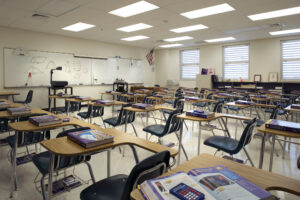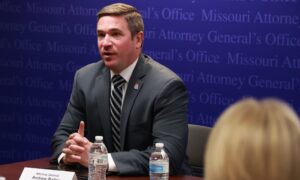13:47
News Story
Kansas City Public Schools won’t arm officers in elementary schools after community feedback
Applause broke out at a Kansas City Public Schools advisory committee meeting on Wednesday when an employee announced the district was moving away from a proposal to add armed officers to elementary schools.
In the end, district administrators heard too much opposition to putting more guns on school grounds — even in the holsters of people in uniform.
Shana Long, the district’s chief legal officer and a member of its Moving Forward Together safety committee, said the decision showed the district listens to parents.
“We want to make sure that you all believe and trust us when we say we’re listening to you,” she said. “This isn’t just us coming to you with a predetermined solution and then just telling you about it.”
Long also said that the district had considered hiring its own officers to carry firearms — not contracting a private security firm.
The decision comes as the district tries to show it’s involving the community, particularly parents, in decisions that affect schools.
District officials were already reeling when their proposal to close 10 schools caught the public off guard last fall and provoked angry opposition even though they had sought feedback in advance.
After scaling back the school closures — it only closed two — KCPS launched its Moving Forward Together effort to improve engagement.
When administrators, motivated by mass school shootings like the one in Uvalde, Texas, started to talk about adding armed officers to elementary schools, they brought the idea to the Moving Forward Together safety committee. After that, they took it to a broader group of parents.
Ashley Johnson, a parent, community organizer and District Advisory Committee vice chair, said the risk of mass shootings doesn’t top the list of concerns for many parents. Rather, she said they’re more concerned about meeting students’ basic needs for stable housing and food security.
“The feedback that we got … was really robust,” she said. “If we have issues involving gun violence, it’s not at a mass shooting level.”
She hopes the decision means the district can now focus on solutions to real problems.
Pros and cons
Decisions about school safety should factor in data rather than emotions, personal worldviews or wishful thinking, Vaughn Baker, president of security company Strategos International, said during a presentation at a KCPS discussion session.
But some parents who spoke at the recorded meeting or submitted comments to an online platform questioned whether, in presenting statistics about the timing of deaths during mass shootings, Baker had made a data-based case that armed officers would help keep students safe.
Parents came prepared with statistics from scholarly articles that cast doubts on whether armed guards would help during a mass shooting and expressed concerns that their daily presence might hurt students.
A smaller number disagreed, saying they thought armed officers would make schools safer and that students would understand they were protectors.
Melvin Livingston, an associate professor at Emory University’s Rollins School of Public Health, said in an interview that schools are in a tough spot because they have to weigh potential harms — such as evidence that police officers assigned to schools increase expulsions and criminal referrals — against uncertain benefits.
Livingston’s research didn’t reach a conclusion on the impact of officers during shootings.
“If there’s an effect either way, it’s not strong enough that it shows up in the data,” he said. That means the range of plausible estimates, he said, “goes anywhere from ‘yeah, this could help’ to ‘this could hurt.’”
Benjamin Brown, a professor of criminal justice at the University of Texas Rio Grande Valley, said research on arming officers in elementary schools is particularly scarce because it’s not as common as stationing officers in high schools or middle schools.
“Ordinarily, the school police are not there just to deter an outside threat,” he said.
Those attacks, he said, are just too rare to measure officers’ impact on safety.
And even when officers are instructed to stay out of normal student discipline, they can have mission creep, said Denise Gottfredson, a professor emeritus from the department of criminology and criminal justice at the University of Maryland.
“They’re trained to recognize certain behaviors as potentially illegal,” she said, and administrators can come to rely on them. In response to what used to be seen as “normal kid behavior” deserving a less formal response from the school, “kids end up being expelled or arrested or both.”
Gottfredson isn’t aware of any studies focused on the specific impacts in elementary schools but said there’s been a push to add police officers to elementary schools since the Sandy Hook shooting in 2012.
KCPS already has a security force, with sworn officers hired directly by the district and licensed through the Kansas City Police Department. Some of those officers are unarmed and based in specific school buildings while others are armed patrol officers. Separately, several armed KCPD officers are assigned to the school district.
All KCPS middle schools and high schools already have armed officers, said Derald Davis, deputy superintendent, and he knows of other local districts that have added them to elementary schools: North Kansas City and Fort Osage.
Johnson, the DAC vice chair, said she appreciated that the district consulted with the community before following those districts.
“It all came with actually listening to the parents, listening to the community members and stakeholders, that this is not what we want,” she said.
This article first appeared on The Beacon and is republished here under a Creative Commons license.
Our stories may be republished online or in print under Creative Commons license CC BY-NC-ND 4.0. We ask that you edit only for style or to shorten, provide proper attribution and link to our website. AP and Getty images may not be republished. Please see our republishing guidelines for use of any other photos and graphics.





